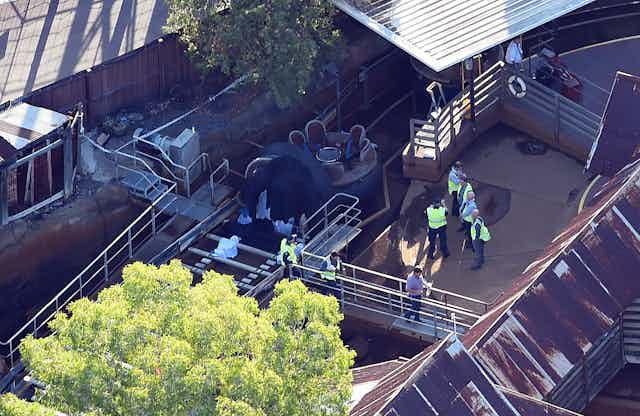Investigations are under way following the tragic accident at the Dreamworld theme park on the Gold Coast on Tuesday that left four people dead.
Queensland Police say initial investigations show that six people were on board one of the rafts on the Thunder River Rapids ride when it “impacted” with another raft. This caused the raft to upturn.
Luke Dorsett, 35, and his sister Kate Goodchild, 32, Dorsett’s partner, Roozi Araghi, 38, and Cindy Low, 42, from New Zealand, died at the scene.
A 10-year-old boy and a 12-year-old girl escaped uninjured in what one police officer described as a “miracle”.
There will be a coronial investigation into the four tragic deaths. The coroner has wide powers of investigation and can request additional reports, statements or information about the death.
Additional information may be obtained from investigators, police, doctors, engineers, workplace health and safety inspectors, mining inspectors, air safety officers, electrical inspectors or other witnesses.
Once the coroner has completed these enquiries, he will consider whether to hold an inquest into the deaths. The coroner will consult with the family about this and the families can also request the coroner to hold an inquest.

Safe rides
That the deaths occurred at a place designed for fun and amusement makes it all the more tragic. But statistically, amusements rides are very safe.
Figures from the Health Safety Executive in the UK confirm that there is one death in 834,000,000 rides.
This is very small when compared with deaths from aircraft travel, where the HSE reports there is one death for each 125,000,000 passenger journeys, or scuba diving where there is one death for every 200,000 dives.
In Australia amusement rides and devices are controlled by the Work Health and Safety Legislation.
The rules vary between jurisdictions, but have their origins in the old Machinery Acts, as amusement rides are for all intents and purposes potentially hazardous pieces of machinery to which the general public is exposed.
Worksafe Australia defines an amusement device as:
[…] an item of plant operated for hire or reward that provides entertainment, sightseeing or amusement through movement of the equipment, or part of the equipment, or when passengers or other users travel or move on, around or along the equipment.
Standards of design
The Dreamworld Thunder River Rapids Ride has been operating since December 1986. At the time of installation there was no Australian Standard specifying the minimum design and construction safety requirements for any amusement rides in Australia.

The first Amusement Rides and Devices Australian Standard was published some two years later, as AS 3533:1988. This Standard has been constantly updated and amended with more and more detail and guidance.
It is worth noting that this Standard is classified as mandatory, as it is called up in legislation. This means that amusement ride operators are breaking the law if they do not comply with its requirements.
There is a separate Australian Standard AS 3533.2:2009 that is dedicated to the operation and maintenance of rides, where Section 5 says:
All maintenance, replacements, repairs and inspections of amusement rides and devices, including discrete systems and components within them, shall be carried out by competent persons and shall be —
a) wherever possible, in accordance with the designer or manufacturer’s instructions;
b) fully documented; and
c) recorded in the log with the device or recorded and kept elsewhere for future reference (see also Clause 5.5).
In the absence of instructions from the designer or manufacturer, those competent persons involved in the maintenance, replacement, repair and inspection of amusement rides should be able to demonstrate a knowledge of the original intentions of the designer or manufacturer.
Safety checks
Planned maintenance programs and inspection routines should be implemented for the moving and load-bearing components and structural members of an amusement device.
This is to maintain mechanical and structural integrity. It is also designed to identify areas where excessive rust, wear, fatigue or any other condition could lead to the failure of such components and compromise the safety of patrons and operating staff.
Maintenance plans should be reviewed based on the results of previous inspections and updated to address any identified needs.
Following major maintenance and repair, and at random intervals on other occasions, a hazard identification and risk assessment procedure should be completed to make sure new hazards are not present and residual risks identified by the designer or manufacturer are not increased.
Provided an amusement ride is adequately maintained in accordance with the relevant Australian Standard, it should be able to operated safely indefinitely.
So what went wrong at Dreamworld yesterday? It’s too early to say what the investigation will uncover.
But it is important to note that it is the norm for the coroner to make recommendations about broader issues connected with the deaths. This could include amendments to the Standards Australia AS 3533 to ensure that a tragedy such as this can never happen again.

